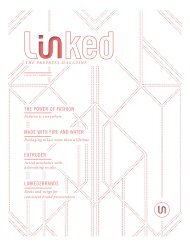Janoschka magazine_Linked_V2_2017
Create successful ePaper yourself
Turn your PDF publications into a flip-book with our unique Google optimized e-Paper software.
42<br />
n e t w o r k & p e o p l e<br />
japan<br />
It is quite different in Japan. As is typical for this country,<br />
complexity is met with purism. A single line pattern is sufficient<br />
for Japanese children to master the great challenge<br />
of their written language. This is basically made up of four<br />
different systems: the two syllabic scripts of Hiragana and<br />
Katakana, with 46 characters each, the Chinese characters,<br />
Kanji, and from the Latin letters, Romaji.<br />
Kanji mostly express whole words and are correspondingly<br />
complex. They have their origin in Chinese characters, of<br />
which there are between 50,000 and 80,000. The Japanese<br />
adopted around 15,000 of them. To read a simple<br />
newspaper article in Japan requires knowing over 2,000<br />
kanji. In daily life, the characters of these four systems are<br />
all mixed in together, so that Japanese texts make particularly<br />
high demands of the pupils<br />
Such a large number of characters can only be mastered<br />
with constant practice and repetition. Japanese line layout<br />
is a simple but clever tool for this. Squares with sides<br />
of two centimetres are divided into four equal squares by<br />
two lines that cross at the centre. This cross gives those<br />
who are learning an orientation for the correct proportion<br />
of the character and for the positioning of the individual<br />
elements. This can be repeated column by column. At the<br />
next exercise level, the characters can each be written,<br />
substantially smaller, four times in the box.<br />
With pen and paper for more<br />
expression and self-confidence<br />
The skill of handwriting is, meanwhile, regarded almost as<br />
a traditional cultural technology and teaching how to write<br />
is regularly questioned: the digital being swipes, clicks and<br />
types. However, it seems that not only personality can be<br />
inferred from handwriting: studies have shown that people<br />
who have developed a handwriting style, also possess<br />
many abilities and potential; they have better powers of<br />
concentration, can remember and understand texts better,<br />
achieve better academic results and experience an<br />
increase in their self-confidence as well as in their ability<br />
to express themselves creatively. It only remains to hope<br />
that many generations of pupils still learn to write with<br />
classical school exercise books – on whatever manner of<br />
lined page.<br />
Few guide lines – great effect:<br />
all the strokes have their exact<br />
position and proportion.









